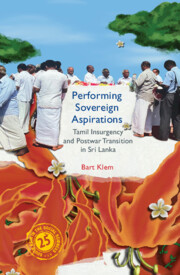Book contents
- Frontmatter
- Dedication
- Contents
- List of Illustrations
- Acknowledgements
- A Typographical Note on Separatism
- List of Abbreviations
- 1 Introduction
- 2 Sovereignty, Performativity and Tamil Nationalism in Sri Lanka
- 3 Performing an Insurgent Sovereign Experiment
- 4 Reconstituting ‘Pure Tamil Space’ after Sovereign Erasure
- 5 The Bureaucratic Evolution of Devolution
- 6 Tamil Nationalist Anti-politics in the Wake of Defeat
- 7 Conclusion
- Epilogue
- Glossary
- References
- Index
Epilogue
Published online by Cambridge University Press: 30 April 2024
- Frontmatter
- Dedication
- Contents
- List of Illustrations
- Acknowledgements
- A Typographical Note on Separatism
- List of Abbreviations
- 1 Introduction
- 2 Sovereignty, Performativity and Tamil Nationalism in Sri Lanka
- 3 Performing an Insurgent Sovereign Experiment
- 4 Reconstituting ‘Pure Tamil Space’ after Sovereign Erasure
- 5 The Bureaucratic Evolution of Devolution
- 6 Tamil Nationalist Anti-politics in the Wake of Defeat
- 7 Conclusion
- Epilogue
- Glossary
- References
- Index
Summary
I wrote the initial drafts of this book over the period November 2018 to April 2020. Every time I had finished a draft chapter, Sri Lanka's appetite for power-sharing seemed to have crumbled further. The scene at the Galadari Hotel and the dim prospects of devolution in the concluding chapter are reflective of this. With Gotabaya Rajapaksa's election to president in late 2019 a new era appeared to start, and I decided to draw a line under my analysis. Academic books cannot continue to keep up with events, and it would be foolhardy to try.
Or so I told myself. Until an economic maelstrom of debt and shortages precipitated a popular uprising that ousted the Rajapaksa government, leaving Sri Lanka's entire political landscape in disarray. With the resulting whirlwind of ideas, hopes, puzzles and disillusions – as present in many readers’ minds as in mine, I presume – an epilogue is warranted to grapple with the afterthoughts to this book. As my manuscript wormed its way through the academic machinery of reviews and revisions, radio stations called me to comment on a country that appeared to have changed beyond recognition. Everything that had seemed unchangeable – the very genetic coding of Sri Lanka's political system and culture – got in flux. Through the aragalaya (struggle), as the uprising came to be known, the edifice of the state and its foundation of a sovereign people made a volte-face in the first half of 2022 – only to land roughly where they had always been, though maybe not quite, in the second half of that year. Many of the characteristics of this revolt connect to the central concerns of this book.
In late 2021 and early 2022, Sri Lanka spiralled into a foreign debt trap. The seeds for this had been sown in the immediate aftermath of the civil war, when the Rajapaksa government initiated a lending spree to bankroll a trajectory of postwar development that combined sensible infrastructural upgrades with misguided megalomanic prestige projects, as well as soaring corruption (Ruwanpura 2016). The impressive growth figures of the immediate postwar years and visions of becoming a new Malaysia or Singapore muted concerns over the debt burden from multilateral, Chinese and other loans.
- Type
- Chapter
- Information
- Performing Sovereign AspirationsTamil Insurgency and Postwar Transition in Sri Lanka, pp. 176 - 181Publisher: Cambridge University PressPrint publication year: 2024
- Creative Commons
- This content is Open Access and distributed under the terms of the Creative Commons Attribution licence CC-BY-NC 4.0 https://creativecommons.org/cclicenses/

